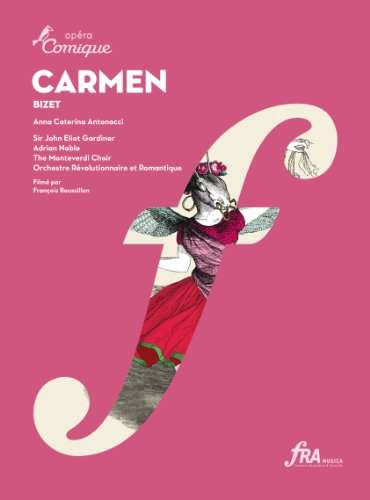|
Back
10/28/2010
Georges Bizet: Carmen
Anna Caterina Antonacci (Carmen), Andrew Richards (Don José), Anne-Catherine Gillet (Micaëla), Nicolas Cavallier (Escamillo), Virginie Pochon (Frasquita), Annie Gill (Mercédès), Matthew Brook (Zuniga), Riccardo Novaro (Moralès), Françis Dudziak (Le Dancaïre), Vincent Ordonneau (Le Remendado), Simon Davis (Lillas Pastia), Lawrence Wallington (Guide), Mehdi Fengal (Infant), The Monteverdi Choir, La Maîtrise des Hauts-de-Seine Children’s Choir, Gaël Darchen (Choir Director), Revolutionary and Romantic Orchestra, Sir John Eliot Gardiner (Conductor), Adrian Noble (Director), Mark Thompson (Set and Costume Designer), Jean Kalman (Lighting Designer), Sue Lefton (Choreographer), François Roussillon and Toni Hajal (film directors)
Filmed at the Opéra Comique, Paris (June 2009) – Running time 170’ (Bonus supplement: 21’)
A co-production with Opéra Comique and the Grand Theater of Luxembourg in association with the Festival Internacional de Música and Danza Granada
fRA Musica Ref #: FRA004 – Booklet in French, English, German, Spanish and Italian – Subtitles available in French, English, German, Spanish and Italian

Delving into the historical context of Georges Bizet’s timeless masterpiece, Carmen, is an unquestionably fascinating journey. Musicologist Richard Langham Smith, in collaboration with Director Adrian Noble and Conductor Sir John Eliot Gardiner return to the Opéra Comique, home of the opera’s premiere on March 3, 1875, in order to recreate (on all levels) the experience the audience may have witnessed on opening night. In summary, we have an extraordinarily refreshing production.
The strength of the cast is evident in all aspects. Anna Caterina Antonacci’s interpretation of the femme fatale has requisite qualities: a smoky, sultry mezzo voice with burning seductiveness without being overacted. She commands the stage and she entrances. American tenor Andrew Richards develops his character in stellar fashion, deftly transitioning through a series of emotions, from appearing a bit coy when meeting the indomitable gypsy for the first time and ending with catatonic fire outside the bullring. His “La fleur que tu m’avais jetée” is sung with ardent warmth. One of the most beautiful voices in this production is that of Micaëla sung by Anne-Catherine Gillet. Her buttery gossamer notes emerge effortlessly, easily reached within her tessitura while the pathos are innate. Her youthful innocence surfaces during the Don José duet in Act I, but she reappears as a woman exuding magnanimous fortitude during her impassioned “Prière” in Act III.
Young French baritone Nicolas Cavallier does an ample job as the confident and haughty Escamillo. He creates the right amount of friction in the mad love triangle that ensues between Carmen, Don José and himself. Carmen’s partners in crime, Frasquita and Mercédès, sung by Virginie Pochon and Annie Gill, respectively, are filled with a charming and perky flair, especially during the card trio. When adding Dudziak’s Le Dancaïre and Ordonneau’s Le Remendado along with Antonacci, we have the makings of a witty and brilliantly executed Smuggler’s Quintet, “Nous avons en tête.”
Mark Thompson’s minimal sets work well in this rather intimate theater by adding only a few props to each act alongside the permanently anchored curvilinear and sloped balcony. The visuals result in a timeless setting, and they are appropriately enhanced by the magic of Jean Kalman in the lighting sector to help accentuate Sir John Eliot Gardiner’s musical interpretation. This combination sharpens the focus on the characters, the real essence of the opera. The costumes, also compliments of Mr. Thompson, contain somber and muted coloration with pockets of bright fabric that aptly depict the depth and breadth of the verismo work.
Through the camera lens one witnesses pronounced expressions found on each cast member and feels totally immersed in the spectacle from start to finish. The singing is clear and sharp with pinpoint enunciation amongst the majority of principals. Despite the confines on stage, Sue Lefton is innovative in her simple yet highly effective choreographic movements.
Since its inception at the Opéra Comique in 1875, Carmen has resulted in three different versions: pure Opéra Comique, the Fritz Oeser version and the Ernest Guiraud version. Mr. Noble chooses the pure Opéra Comique route by retaining spoken dialogue instead of recitative. This is a very good option. Those fairly versed in Carmen will find a few unexpected items, namely reinstituting a pantomime scene with Moralès and the men’s chorus in Act I, as one example. Sir John Eliot Gardiner’s pacing of the music is brisk and energetic while inserting tempo changes in unexpected places and by adding period instruments to the orchestra, a hallmark tradition in his works.
Upon conclusion of the opera is a twenty one minute supplement entitled, “Carmen returns to the Opéra Comique”, featuring informative commentary by Theatre Director Jérôme Deschamps, Sir John Eliot Gardiner and dramaturge specialist Agnès Terrier. It helps elucidate the events surrounding Bizet’s final opera. I might suggest fast forwarding to this selection first because it helps broaden one’s understanding and adds immeasurable enjoyment to the performance. This is a terrific production and it is highly recommended for anyone who has a love for Carmen.
Christie Grimstad
|